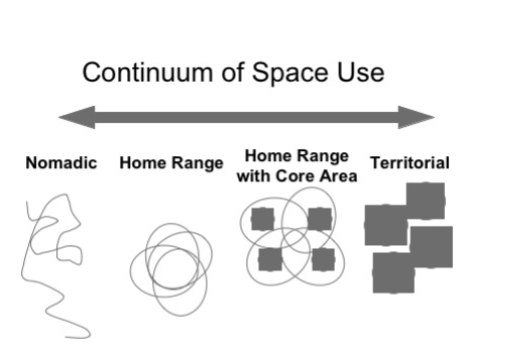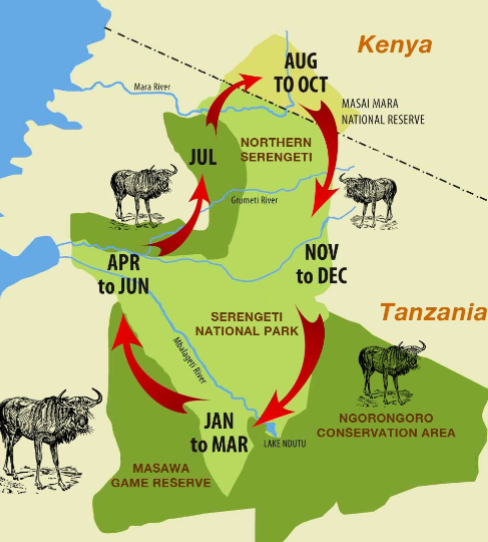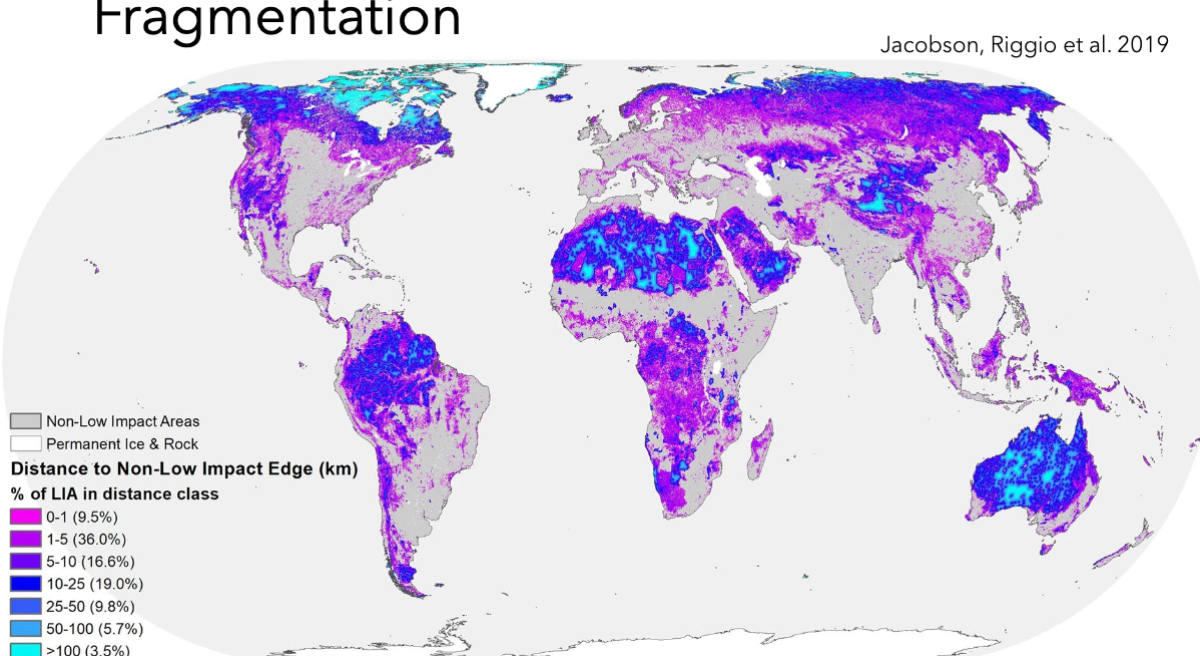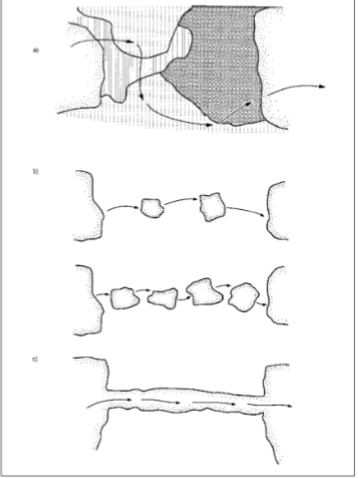M3 Movement patters and spatial relationships
1/46
There's no tags or description
Looks like no tags are added yet.
Name | Mastery | Learn | Test | Matching | Spaced |
|---|
No study sessions yet.
47 Terms
Home Range
the general area in which an animal lives,
characterized by repeated use
• Used for daily activities
• Contains the resources
required for survival and
reproduction
Why have a home
range?
Knowledge of:
- Forage patches or good hunting
grounds
- Safe places to rest
- Nesting or denning sites
- Other conspecifics – competitors or
mates
- Places with high predator densities or
predation risk
Information is power!
A key feature of
home ranges?
site fidelity
site fiidelity
repeated use of a small area,
generally to perform a specific behavior
• Travel corridors
• Den sites
• Hunting or foraging areas
• Social interactions
Can an animal have a home range but not high
site fidelity?
• Yes! (if we are talking small scales)
• Within a familiar range, animals can use
similar habitat types that allow for
efficient foraging, effective refuge use,
knowledge of predators/competitors
Are home
ranges static?
Annual shifts in home ranges
season, weather, etc.
Determinants of home
range size
• Body mass: larger animals have larger home range (need more resources - carnivores need larger home range size. Less caloric variability in a landscape when comp. to herbivore. Marine mammals have greater home range size given body mass - but even same size its stilll bigger.
• Environment: Sens. to humans; large mammals tend to diss. first
• Diet
territory
very specific type of home range. the area of an animal’s home range that it defends from conspecifics
• Actively defended
• Contains resources an
animals wants to control and
restrict access to by others
space use from none to high
nomadic, home range, home range with core area, territorial

Territory
defense
• Defended by
• Direct conflict
• Communication (visual presence and
displays, scent marking,
vocalization)
by communication may be more
common because it is safer, and therefore
is selected for (in an evolutionary sense)
Territory defense: who defends a territory
• Individual
• Mating pair
• Family or communal group
what is the problem with the santa monica mountains and mtn lion
constrained space, territory is overlapping. may be result of death due to more competiton
can change due to environmental, anthropogenic conditions
territory defense for mountain lions: who, how, and limiting resource
• Who? Individual males defend against
other males
• How? Scent marking and direct conflict
• Limiting resource? Breeding
opportunities
territory defense for beavers: who, how, and limiting resource
• Who? Mating pair
• How? Scent marking and direct conflict
• Limiting resource? Food & lodge sites
territory defense for chimpanzee: who, how, and limiting resource
• Who? Group defend against other
groups
• How? Boundary patrols
• Limiting resource? Food, breeding
opportunities
Territorial
behavior should
only arise if a
resource can
reasonably (and
economically) be
defended: mountain lion
Female home ranges are relatively stable and related to food availability,
denning habitat
Territorial
behavior should
only arise if a
resource can
reasonably (and
economically) be
defended: beaver
Lodge site availability is related to stream/pond and meadow
characteristics (e.g., surrounding willows for food and construction
materials)
Territorial
behavior should
only arise if a
resource can
reasonably (and
economically) be
defended: chimp.
Fruiting trees and other food resources are related to habitat type
How do home ranges help us
understand wildlife ecology (4)
Selection for resources
• Where are animal home ranges relative to the landscape?
• How to animals preferentially use habitats within their home ranges?
Area requirements
• How much space do animals need?
• Do their home ranges overlap or not (territoriality)?
Energetics and behavior
• How much do animals move? Why? What is the cost of that movement?
How resilient are animals to environmental change?
• Are the anchored to specific locations? Do they have access to a diversity
of habitat types?
Two major types of dispersal
• Natal dispersal – movement from range where born to
range where first reproduction occurs
• Breeding dispersal – movement to new range between
reproductive events
dispersal
avoidance of inbreeding and reducing local competition
Dispersal has 3 stages:
• Emigration – leave current range
• Dispersal can be genetically hardwired or condition dependent
• Sex ratio, habitat condition, body condition
• Transfer – movement through unfamiliar territory
• Difficult to measure because it is hard to differentiate between failed
attempts to disperse and test-drives
• Immigration – settlement into new range
• Involves habitat selection and social integration
• Dispersers may accept lower quality habitat to fit in
Migration
repeated movements between distinct, nonoverlapping ranges
Migration behavior is
a widespread phenomena across taxa to deal with seasonal
(and otherwise varying) environments
• Typically, the animals that exhibit migration behavior are highly mobile
• Aerial and marine migrants generally move farther than terrestrial migrants
A suitable or preferred ‘habitat’ is not a static condition for many animals
Why is migration important?
• Allows migrants to reach higher densities, or
persist at all!
• Increases growth, reproductive success, or survival
• Provides access to differential resources
required during different times of year
Types of migration: descriptive a-d
spatial position on y axis
year on x axis
xeric animals are usually nomadic (dont go back to space)

Types of migration: descriptive e-g
e. go through migration, but some are residents
usually winter range yr round
f. big events happens to where the animal migrates to a new habitat
still repeated movement to access different resources, but doesn’t hapen every yr. based on resources or weather
g. may have different summer and winter ranges, winter summer a, w.s. b., etc

Facultative migration
animals only migrate
some years, dependent on internal state or
environmental conditions
Partial migration
not all individuals from a
population migrate. Often related to
competition within the population
• Elk
Mixed migration
animals may have different
summer or winter ranges year to year, therefore
they migrate different distances
Latitudinal migration
see this in whales; go north and south
wildebeest (best on wet/dry season and forage avail)
saiga antelope
Altitudinal migration
summer/winter mig.
guanacos, bighorn sheep, elk
moving up slope in summer, moving down slope in winter
Migration that is not related to latitude
or elevation
elephant seal: longitudinal: accessing breeding resource rather than seasonal food resource
types of migration: scales
spatial
regional
local
Temporal
seasonal
Diel: zebras move away front water holes at night
what drives migration
Alimental movement / feeding / tracking
• To increase access to food and water
Climatic movement / wintering / refuge
• To avoid unfavorable conditions
• To avoid predation, parasitism, or
disease
Gametic movement / spawning / breeding
• To access mates or increase offspring
recruitment
Some animals may use all three!

Who migrates? (Ungulate edition): Ruminants (artiodactyls) vs. hindgut fermenters (perissodactyls)
• Ruminants are less tolerant of low-quality forage – migrate for food
• Hindgut fermenters limited by water – migrate for surface water
Who migrates? (Ungulate edition): small vs large body size
• Smallest ungulates to migrate are gazelle, ~50 lb.
• If too small, it’s just not efficient to travel far to look for food!
• Small-bodied ruminants track high quality forage more closely – larger animals can
tolerate lower quality food
• medium-sized ungulates often travel farthest distances
Who migrates? (Ungulate edition): high vs low productivity environments:
• Migration less necessary in high productivity (e.g., tropical) environments
• Also, ungulates are often smaller in high productivity environments
Four stages of migration
• Preparation
• Fuel loading via increased foraging and metabolic
changes
• Movement
• Occurs over land or water, birds and marine
mammals travel farther than terrestrial mammals
• Stopovers
• Settle in habitat to rest and feed, few or many
stopovers
• Arrival
• Territories are reestablished, mates chosen, energy
built up for reproduction
Connectivity
a measure of the ability of
organisms to move among separated patches
of suitable habitat
Key connectivity terms:
• Island biogeography
• Metapopulation
• Dispersal
• Migration
• Matrix: land between suitable habitat patches
even though about half of the earth has low human impact, what is the problem?
High fragmentation in those areas still: roads, fences, etc.

corridors
any space identifiable by species using it that
facilitates the movement of animals or plants over time
between patches of disjunct habitat

what must you consider when making corridors
• Focal species or taxa
• Scale of interest: getting across a road or continent
• Habitat requirements
• Generalists vs. specialists
• Human tolerance
Corridor type and dimensions
small scale, intermediate scale, and large scale corridors difference
small: highway crossing
often reactive
for hard barriers or pinch points
inter.: land purchases or easments
often proactive
for prevention of connectivity loss
Large: collaborative landscape conservation plans
integrative
to link cores across a species’ range
Why Corridors?
• Objectives for individual animals:
• Increase survival
• Increase movement/dispersal ability
• Increase access to resources
Why Corridors?
Objectives for animal
populations:
• Increase genetic viability
• Maintain metapopulation
dynamics
• Increase population growth rate
Why Corridors? Objectives for human well-being
• Reduced risk from vehicle collisions
• Ecosystem services
South Dakota
Within 30 years, cougar reintroduction in the eastern
US could:
• Reduce deer densities and DVCs by 22%
• Prevent 21,400 human injuries and 155 fatalities
• Save $2.13 billion in avoided costs